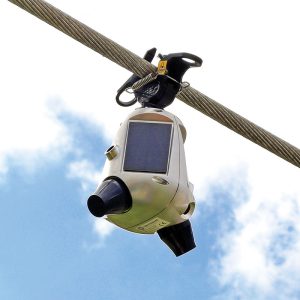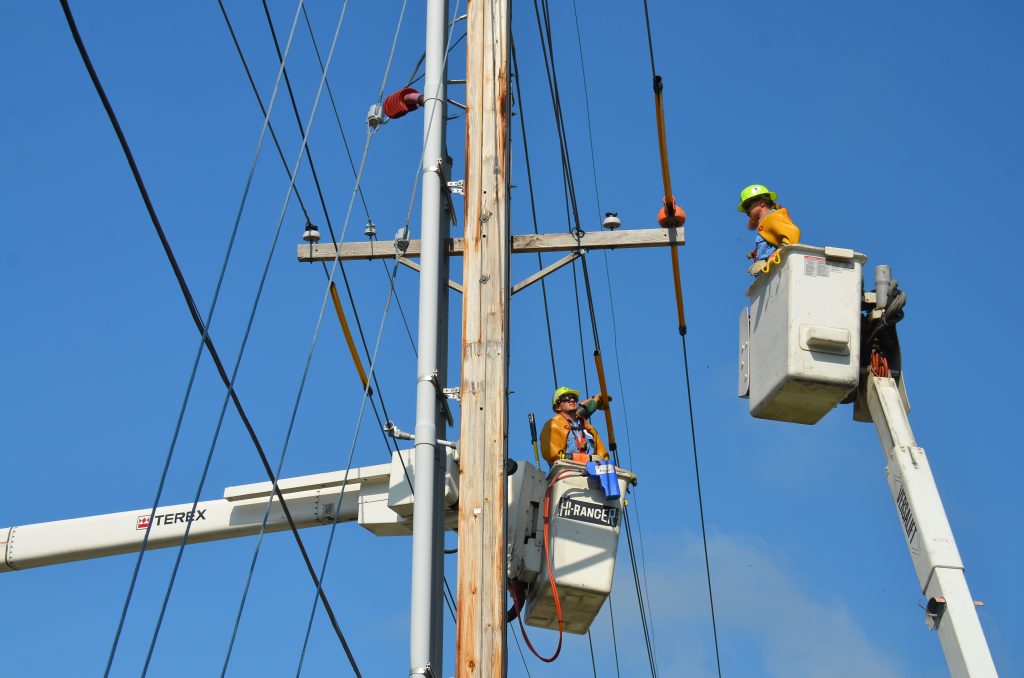What is FERC Order 881?
The Federal Energy Regulatory Commission (FERC) issued FERC Order 881 to overhaul transmission line ratings. This order requires all transmission providers, both inside and outside of organized markets, to use ambient-adjusted ratings by July 12, 2025. These ratings will be used as the basis for evaluating near-term transmission service to increase the accuracy of near-term line ratings.
If you’re reading this you’re likely already familiar with these ratings, but here’s a quick refresher:
Transmission line ratings
Transmission line ratings are used to determine the efficiency and risk of a power line. These ratings fluctuate based on things like temperature and wind speed. On days when the weather can severely impact your transmission lines, line ratings can help inform how much energy to let flow through those lines. This reduces the risk of damage to power lines, equipment, and the environment surrounding your power lines.
However, reduced flow also affects the price of power. Less flow of power on days with inclement weather could hurt your bottom line and the satisfaction of your customers.
Requirement for Transmission Providers to Implement AARs on All Transmission Lines
-
Ambient-Adjusted Ratings (AARs)
Order 881 mandates the use of Ambient-Adjusted Ratings (AARs), which are line ratings updated close to real-time, reflecting short-term forecasts of ambient air temperature. This approach ensures that transmission line ratings are more accurate and dynamic, adjusting to actual weather conditions rather than conservative estimates.
-
Hourly Updates
Regional Transmission Organizations (RTOs) and Independent System Operators (ISOs) must establish systems for transmission owners to electronically update transmission line ratings at least hourly. This allows for more dynamic adjustments based on changing conditions.
-
Transmission Line Relays
Order 881 also addressed the use of transmission line relays. These relays are safety devices that protect the transmission line from damage in case of a fault or overload. FERC emphasized the importance of proper coordination between relays and AARs to ensure that the relays operate correctly under varying temperature conditions, maintaining grid reliability.
-
Use of AARs 10-Days Forward in Transmission Service and Operations
FERC required transmission providers to use AARs in their transmission service and operations planning at least 10 days in advance. This requirement ensures that AARs are considered in long-term planning, allowing for more accurate capacity forecasts and better management of transmission line usage.
-
Seasonal Line Rating Floors
While FERC did not set a minimum transmission line rating, known as a “floor,” it emphasized the importance of accounting for extreme weather conditions when calculating line ratings. Power companies are expected to use current forecasting methods to plan for extreme temperatures, ensuring that the grid remains reliable under all conditions.
-
Minimum AAR Temperature Range and AAR Granularity
FERC required that methods used to determine AARs be valid for at least the range of local historical temperatures, plus or minus a margin of 10 degrees Fahrenheit. Transmission providers must also update AARs with every five-degree Fahrenheit increment of temperature change to ensure accurate and up-to-date ratings.
-
Solar Heating in AAR Calculations
Order No 881 mandated that transmission providers incorporate solar heating effects into AARs by implementing separate AARs for daytime and nighttime periods. They must also update the sunrise and sunset times used in these calculations at least monthly. This requirement ensures that AARs accurately reflect the impact of solar heating on transmission line capacity, leading to more reliable grid operation and potentially lower costs for consumers.
-
Emergency Ratings
Electricity providers must use uniquely determined emergency ratings for contingency analysis and post-contingency simulations of constraints.
-
Transparency
Transmission owners must share their transmission line ratings and methodologies with their providers and market monitors. Transmission providers must maintain a database of these ratings and methodologies on their websites.
- Data Sharing
Utility providers are required to share line rating data in a timely manner upon request. This transparency is essential for efficient grid management and coordination among different providers.
Steps Towards Compliance with FERC Order 881
Assess Capabilities and Develop Roadmap
- Audit your current systems
- Identify gaps in compliance with Order 881
- Prepare a timeline for necessary changes, prioritize critical updates and allocate resources for upgrades.
Implement AAR Systems and Upgrade Data Management
- Choose an AAR system capable of gathering real-time ambient conditions.
- Install the hardware onto your existing infrastructure.
- Upgrade your computers and any other hardware that collects, stores, accesses, and sends information. This may be necessary to handle the hourly updates and to generate 10-day forecasts.
Review Methodologies and Enhance Forecasting
- Revise your internal rating methodologies to include AAR calculations. Don’t forget to account for solar heating and sunrise/sunset times.
- Improve weather forecasting systems to integrate accurate 10-day forecasts and consider extreme weather conditions in line rating calculations.
Train Personnel and Update Procedures
- Develop comprehensive training programs for staff on new AAR tech and software.
- Update operational manuals and procedures for real-time hourly rating updates and 10-day forecast integration.
- Create a new response plan to react to weather changes quickly.
Coordinate and Implement Quality Control
- Engage with RTOs/ISOs to understand their implementation plans and timelines. Use them as resources to better implement your own plans.
- Develop internal auditing processes to ensure compliance, monitor AAR accuracy, and regularly review methodologies.
Prepare for Transparency and Conduct Pilots
- Create a public database to share ratings and methodologies.
- Implement AAR systems on a pilot basis to refine approaches before full implementation.
- A/B test your systems if possible. This will help your implementation strategy and your overall long-term goals.
- Use pilot results to identify potential issues.
Plan for Maintenance and Upgrades
- Develop strategies for ongoing maintenance of AAR systems and sensors. This may require hiring new staff or training existing staff.
- Plan for future upgrades to keep pace with any technological advancements and regulatory changes.
..
Tools for FERC 881 Compliance: Sentrisense

A Sentrisense powerline monitoring unit.
The Sentrisense is a new powerline monitoring AAR system that is FERC 881 compliant. The devices in this system contain numerous sensors to detect various conditions. Some of the benefits are included below:
Increasing Efficiency
Sentrisense enhances the capacity of your power lines, ensuring reliable energy transmission. By optimizing your existing assets, this device lets you transmit more energy safely and effectively.
Extending Asset Life
This AAR system can extend the life of your infrastructure. The data collection capabilities provide insights to help you allocate future investments wisely.
Key Features
Low-Cost, Hassle-Free Installation
Sentrisense makes monitoring overhead power lines simple, fast, and affordable. The sensors can be installed and put into action in under a minute. This ease of setup, combined with a remote, hands-off maintenance approach, represents a breakthrough in cost-efficiency for overhead power line monitoring.
Universal and Fully Adaptable
Sentri sensors are not just versatile, they are universally adaptable and engineered to meet the diverse needs of your grid. Whether your infrastructure is compact or extensive, this technology scales and evolves with your needs and demands. Remote updates enable seamless capability expansion, ensuring that your grid can grow with ease.
Unleash the Power of Your Data
Sentrisense sensors capture real-time, on-site data, directly from your overhead power lines. This enables our powerful analytics models to deliver accurate actionable insights. The choice is yours: leverage the precision of pre-built models, or utilize the information with your analytical tools. Sentrisense power line monitoring network provides full access, ensuring flexibility and control over your grid.
Service Verticals
Quick Incident Detection (QID)
With Sentrisense Quick Incident Detection (QID) capabilities, you can swiftly identify and immediately respond to issues, ensuring uninterrupted power flow, mitigating risks, and enhancing the overall reliability of your system.
Early Fault Detection (EFD)
The Early Fault Detection (EFD) system proactively identifies faults, minimizing downtime, reducing maintenance costs, and enhancing the reliability of your power line infrastructure by predicting potential malfunctions.
Dynamic Line Rating (DLR)
Optimize your energy transmission and future-proof your grid through accurate assessment of real-time environmental conditions, the Dynamic Line Rating (DLR) solution maximizes the transmission capacity of your power lines. This optimization drives efficiency, sustainability, and seamless integration of renewable energy sources.
Sentrisense
Easy to Install
Easily attached to active power lines with no outage required, SENTRI’s drone-compatible design ensures hassle-free installation even in hard-to-reach locations.
Proactive
Built-in, real-time monitoring features allow SENTRI to alert you of any tilting, oscillations, or abnormal vibrations, safeguarding your power lines’ health and longevity.
Self-Sufficient
With more than 10 years of autonomy and a solar panel for self-recharging, SENTRI can run for up to 6 months without any external energy, minimizing maintenance as well as downtime.
Connected
SENTRI offers robust and flexible internet connectivity options, from 3G/4G to WiFi and LoRa, with satellite connectivity available upon request, keeping you connected no matter where your infrastructure lies.
Final Thoughts
Implementing FERC Order 881 and Ambient Adjusted Ratings is critical for the future of energy transmission. By adhering to these guidelines, utilities can improve grid efficiency, reduce costs, and ensure reliable service. Tools like Sentrisense can aid in compliance, offering innovative solutions for monitoring and optimizing transmission line performance.
For more information on how to comply with FERC Order 881 and optimize your energy infrastructure, contact us at PR-Tech at: 503-292-8682.

